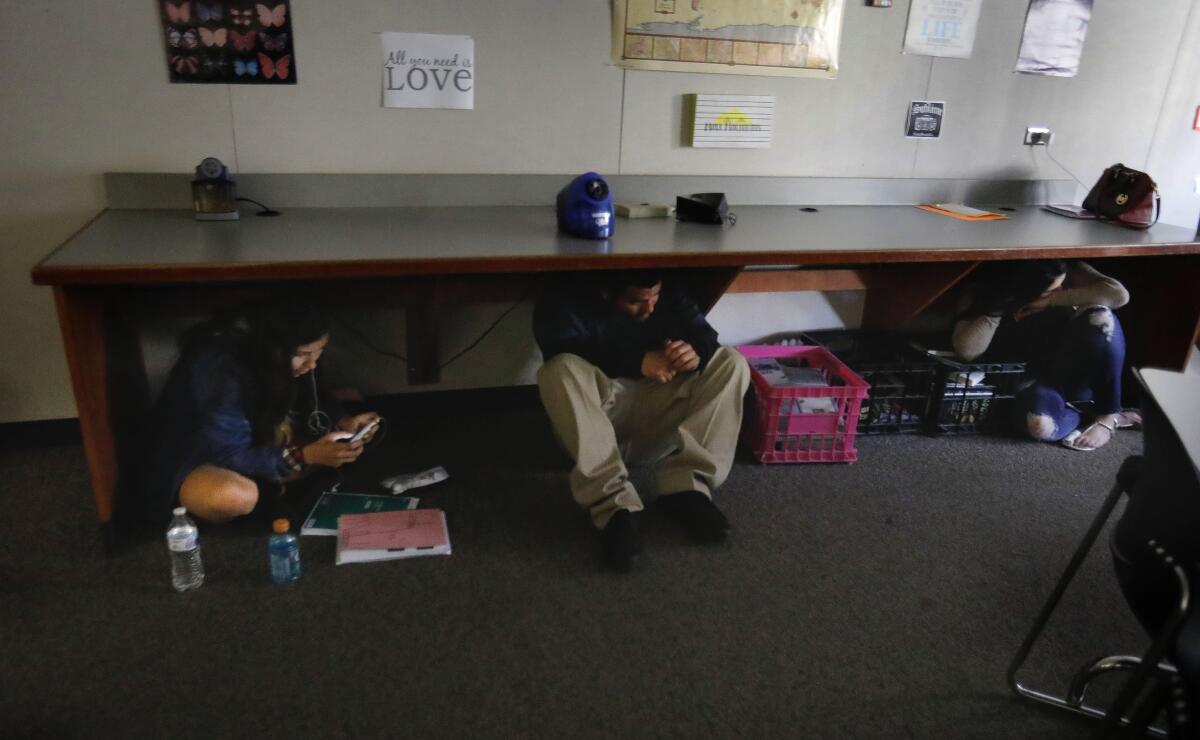High school cancels active-shooter drill with sound of gunfire after receiving a complaint

- Share via
San Marino High School was ready for its active-shooter drill Friday morning. City police officers planned to fire blank cartridges over 11 minutes to familiarize students with the sound of gunfire. Staff would teach students about a protection strategy called “run, hide, fight” in the event of a shooting emergency.
But the American Civil Liberties Union intervened and asked Principal Issaic Gates to stop the drill, concerned that it could be too traumatic for teenagers. On Thursday, the San Marino school district canceled it.
“We of course were deeply concerned with any active-shooter drill, but certainly one where they were going to be shooting guns,” said Sylvia Torres-Guillén, director of education equity for the ACLU of California. “Our objective is to ensure that youth are in schools that are sanctuaries of learning and not places where they’re inflicted with trauma.”
Schools across California and the nation are increasingly practicing active-shooter drills in the face of gun violence on campus. At least 16 states, including California, now require or encourage schools to carry out active-shooter drills, according to one analysis, and 95% of schools nationwide conducted a drill in the 2014-15 school year, according to the National Center for Education Statistics.
But there is growing backlash among mental health professionals, some school safety experts and others about the graphic nature of live drills, which sometimes include fake gunfire and simulations of violent attacks that use teachers and students as actors. Such events can provoke unnecessary anxiety and cause mental health harm without providing clear safety benefits, they say.
In a recent report by the gun control advocacy group Everytown for Gun Safety Support Fund and the nation’s two largest teachers unions, the American Federation of Teachers and the National Education Assn., the organizations voiced opposition to such drills because of their anxiety-producing effect on some children and staff.
Melissa Reeves, former president of the National Assn. of School Psychologists, said in the report that “what these drills can really do is potentially trigger either past trauma or trigger such a significant physiological reaction that it actually ends up scaring the individuals instead of better preparing them to respond in these kinds of situations.”
Two years ago, San Marino High, a 1,050-student campus in one of the county’s most affluent neighborhoods, conducted a simulation drill that involved a police presence, mock shooter and students trapped in a stairwell. After the drill Alex Cherniss, who was the school district’s superintendent at the time, said in a recorded television interview: “This is not something we want to do. It is something we have to do.”
Gates, the San Marino High principal, said Thursday that the ACLU complaint contributed to his decision to cancel Friday’s drill. He acknowledged that the thinking on drills had evolved in recent years — and district staff had already been discussing alternative formats and ways to engage the broader community.
“The design of the drill, while we thought it was safe, if we receive new information, we’re going to implement it,” he said.
The gunfire portion of the drill was to have included three officers stationed at two on-campus parking lots firing about 15 rounds of blank cartridges into the ground for about 11 minutes, said San Marino Police Sgt. Tim Tebbetts.
“It’s really to acclimate people to what gunfire would sound like in a safe environment. ... It’s so they don’t panic,” Tebbetts said.
The drill would also have included a PowerPoint presentation and teacher-led discussion with students about how they might run, hide or fight, and a schoolwide assembly with the local police and fire departments, superintendent and counselors.
Gates said students were notified in advance that they would hear gunfire during the drill. He said he had been informing the school community about the planned drill since the beginning of the school year, through informal conversations, PTSA meetings, assemblies, weekly communications with parents, and other efforts. He said the drill was not a simulation, like the one two years ago, but an exercise to increase their “situational awareness.”
“The idea is to prepare, not scare, kids,” he said.
Gates said he had heard some concerns from parents, but the only complaint he received requesting a cancellation of the drill was from the ACLU. While he recognized that the drill could cause anxiety and trauma, he defended it as a necessity.
“Unfortunately I have to recognize that this is the new normal,” he said. “How do we best prepare our kids for this?”
Amber Nuuvali, chief communications officer for the San Marino Unified School District, said that the district will focus now on planning a communitywide event on preparing for an active shooter, and on applying for a federal grant under the STOP School Violence Program.
More to Read
Sign up for Essential California
The most important California stories and recommendations in your inbox every morning.
You may occasionally receive promotional content from the Los Angeles Times.











